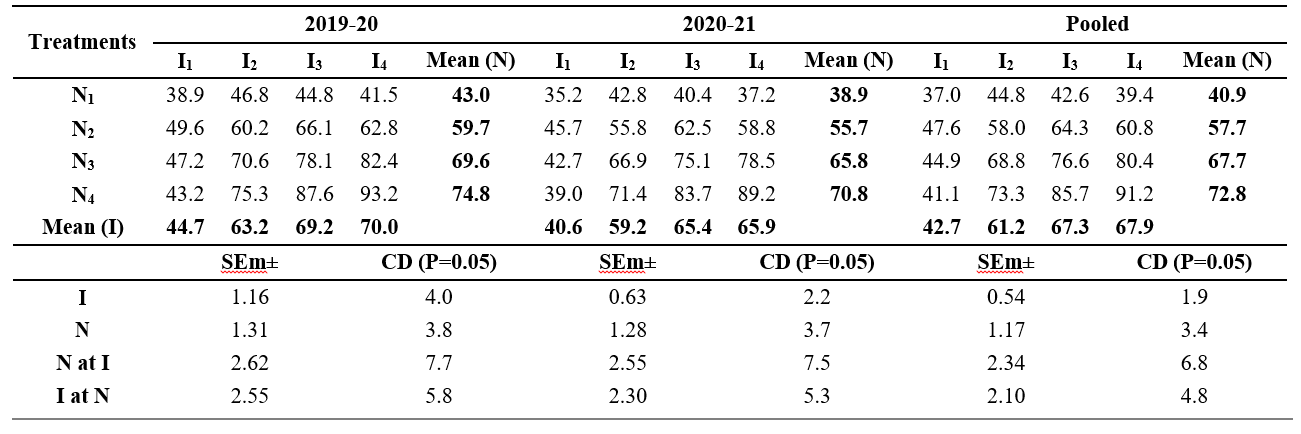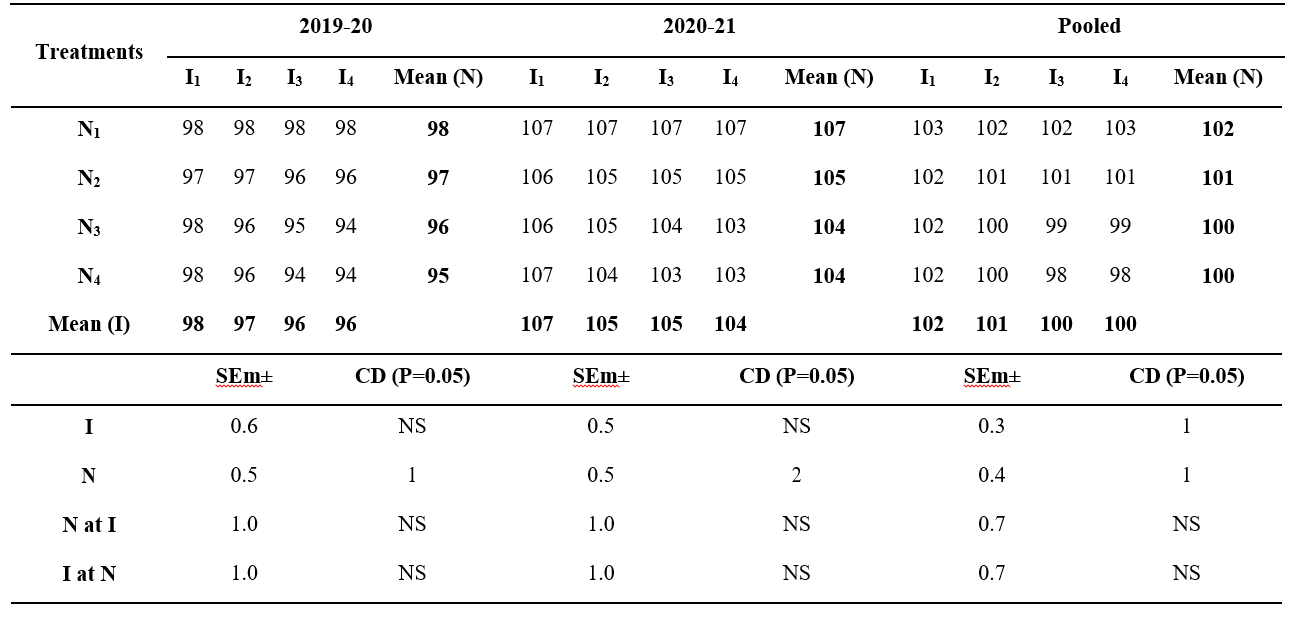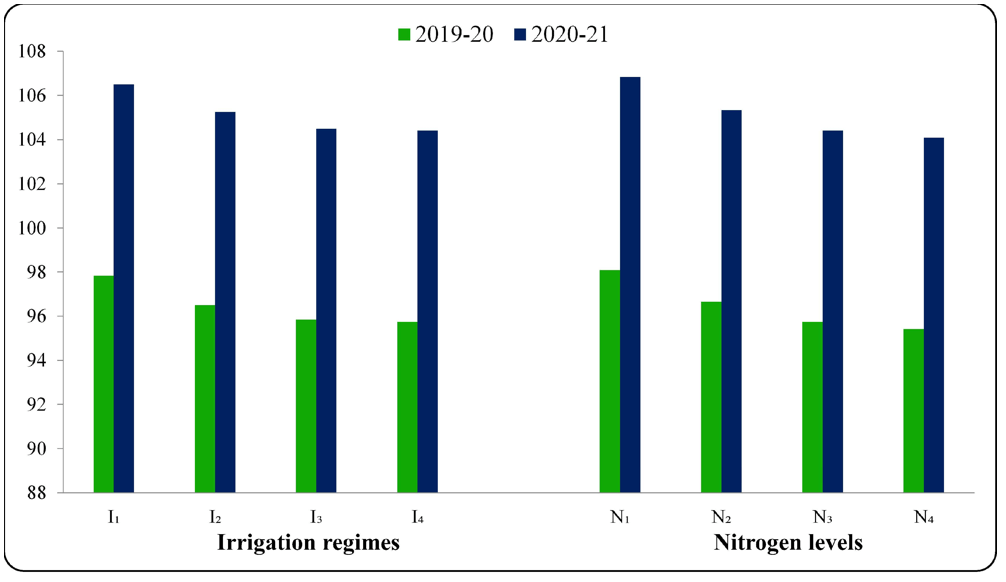Effect of Irrigation Regimes and Nitrogen Levels on Phenology of Aerobic Rice (Oryza Sativa L.) Under Drip Irrigation
0 Views
B. RAGHAVENDRA GOUD*, G. PRABHAKARA REDDY, V. CHANDRIKA, M.V.S. NAIDU,P.SUDHAKAR, K. MADHUSUDHANA REDDY and G. KARUNA SAGAR
Scientist, ICAR-National Rice Research Institute, Cuttack, Odisha
ABSTRACT
A field study was conducted at S.V. Agricultural College, Tirupati during rabi seasons of 2019-20 and 2020-21 to study the effect of drip irrigation regimes and nitrogen levels on phenology of aerobic rice. The field experiment was laid out in split plot design with three replications by taking irrigation regimes (Drip irrigation at 1.25 Epan, 1.50 Epan, 1.75 Epan and 2.0 Epan) as main plots, and nitrogen levels (90 kg N ha-1, 120 kg N ha-1, 150 kg N ha-1 and 180 kg N ha-1) as sub plots. Higher leaf area duration (LAD) was observed with drip irrigation regime of 2.0 Epan which was however comparable with drip irrigation at
1.75 Epan) at different intervals of crop growth except at 0-30 DAS interval, wherein irrigation regimes did not have significant influence on LAD. The lower LAD was observed with drip irrigation regime of 1.25 Epan at all the stages of crop growth. As regards to nitrogen levels higher LAD was observed with 180 kg N ha-1 which was however comparable with 150 kg N ha-1 at 30 DAS, and the lower value was observed with 90 kg N ha-1. In the pooled mean, drip irrigation regime of 2.0 Epan and 1.75 Epan took significantly less number of days to attain 50% flowering over 1.5 Epan and 1.25 Epan. Aerobic rice supplied with 180 kg N ha-1 took less number of days to attain 50% flowering followed by lower doses and 90 kg N ha-1 took longer duration to attain 50% flowering. Number of days to maturity was non-significant due to irrigation regimes and nitrogen levels during both the years of study and in the pooled mean.
KEYWORDS: Aerobic rice, days to 50% flowering, drip irrigation regimes, leaf area duration, nitrogen levels
INTRODUCTION
Rice is the staple food for more than half of the world population and is generally grown under puddled transplanted conditions. Conventional puddled transplanted rice cultivation requires over 2000 mm of water and is labour, water, and energy expensive. Global water crisis threatens the sustainability of irrigated rice system due to reduced availability of water. Therefore, future production of rice to meet food needs of growing population has to be achieved using less resources such as land and water through more efficient production systems. In this direction, aerobic rice can drastically reduce water requirement and improve water use efficiency. Aerobic rice is grown under non-puddled, non- flooded and non-saturated soil conditions as other upland crops (Prasad, 2011). Growing aerobic rice with drip irrigation will meet water requirement of the crop as and when needed. Nitrogen fertilizer along with irrigation can increase crop yield greatly, however, response of nitrogen varies with the available soil moisture content. As stress due to moisture and nutrients results in variation in phenological parameters like LAD, days to 50% flowering and maturity, present study was conducted to know the influence of different irrigation regimes and nitrogen levels on phenology of aerobic rice.
MATERIAL AND METHODS
The experiment was conducted during two consecutive rabi seasons of 2019-20 and 2020-21 at wetland farm of S.V. Agricultural College, Tirupati of Acharya N.G. Ranga Agricultural University, Andhra Pradesh. The soil was sandy clay loam with slightly alkaline pH, low in organic carbon, available nitrogen and phosphorus and medium in available potassium. Field experiment was laid out in split plot design with three replications. Treatments consisted of four irrigation schedules (I1: Irrigation at 1.25 Epan, I2: Irrigation at 1.50 Epan, I3: Irrigation at 1.75 Epan and I4: Irrigation at 2.0 Epan) as main plot treatments and four nitrogen levels (N1: 75% RDN (90 kg N ha-1), N2: 100% RDN (120 kg N ha-1), N3: 125% RDN (150 kg N ha-1) and 150% RDN (180 kg N ha-1)) as sub plot treatments. Healthy and viable
seeds of NLR-34449 rice variety were sown by hand dibbling at the rate of two seeds per hill by maintaining spacing of 20 cm × 10 cm. Two uniform irrigations were given to all the treatments during the first 20 days of crop period for proper germination and establishment of crop. Drip irrigation was given on every alternate day based on pan evaporation (Epan) data according to the treatment requirements. Quantified water was supplied by measuring with water meter. The recommended dose of fertilizer was 120 : 60 : 40 kg NPK ha-1. At the time of sowing, full quantity of phosphorus as SSP along with half dose of potassium as MOP were applied as basal. In addition, ZnSO4 and FeSO4 @ 25kg ha-1 were applied before sowing. Nitrogen fertilizer dose in different treatments was applied in three equal splits at 15 DAS, tillering and panicle initiation stages. Leaf area duration (LAD) for different crop intervals was calculated using the LAI at each sampling date. The LAD between two sampling time points was approximated according to the equation:

where, t1 and t2 are the sampling times and LAI1 and LAI2 area duration. Similar results of increase in leaf area duration with increase in soil moisture were reported by Winkel et al. (2001), Sudharani (2007) and Halli et al. (2021) in bajra, baby corn and maize, respectively. Whereas, lower LAD was noticed with drip irrigation scheduled at 1.25 Epan due to moisture stress which resulted in accelerated leaf senescence. LAD was correlated with relative leaf water content.
Among the different nitrogen levels, 180 kg N ha-1 registered higher LAD at 30-60 DAS, 60-90 DAS and 90 DAS-harvest intervals during both the years of study and in the pooled mean, which was significantly superior to that of 150, 120 and 90 kg N ha-1. Whereas at 30 DAS, it was comparable with the application of 150 kg N ha-1. Increased dose of Nitrogen from 90 to 180 kg N ha-1 resulted in an increase in leaf area duration which might be due to enhanced tiller growth, production of higher vegetative biomass and higher LAI at higher nitrogen doses. Similar findings were reported by Sainio et al. (1997) and Xiaolong et al. (2017).
With regard to interaction, scheduling drip irrigation at 2.0 Epan in combination with 180 kg N ha-1 resulted in higher LAD followed by 1.75 Epan in combination with are values of LAI at the sampling times t1 and t2 respectively.
RESULTS AND DISCUSSION
Leaf area duration
In this study, leaf area duration (LAD) tended to increase up to 90 DAS, later on declined towards harvest as a result of leaf senescence in all the treatments. Leaf area duration of aerobic rice was significantly influenced by irrigation regimes at different time intervals during crop period, except at 0-30 DAS interval, during which the variation was not statistically traceable due to similar foliar growth because of uniform application of irrigation water during the initial period of crop growth (Table 1, 2, 3 and 4 and Figure1).
At other time intervals, drip irrigation regime of 2.0 Epan recorded significantly higher LAD which was however comparable with the next higher irrigation regime of 1.75 Epan during both the years of investigation as well as in the pooled mean. This might be due to adequate photosynthesis, plant growth and leaf retention under optimum moisture conditions which is linked to a greater LAD. Water use was linearly related to green leaf 180 kg N ha-1. Higher leaf area duration in these treatments might be due to supply of adequate nitrogen under optimum soil moisture conditions facilitating production of higher number of tillers and photosynthetic leaf area. Whereas, the lower LAD was registered with 1.25 Epan along with 90 kg N ha-1.
Days to 50% flowering
Number of days to attain 50% flowering was significantly influenced by nitrogen levels during both the years of study and in the pooled mean, but it was influenced by irrigation regimes only in the pooled mean, while the interaction was not statistically traceable (Table 5 and Figure 2).
In the pooled mean, early flowering was observed with drip irrigation regimes of 2.0 Epan and 1.75 Epan which recorded significantly less number of days to attain 50 % flowering over 1.5 Epan. Whereas, delayed flowering was observed with the lower irrigation regime i.e., 1.25 Epan. Early flowering under higher drip irrigation regimes might be due to favourable soil moisture status for better growth of the crop, which favoured early cessation of vegetative growth leading to earlier initiation of reproductive phase. Whereas, moisture stress faced by
Table 1. Leaf area duration (days) at 0-30 DAS interval of aerobic rice as influenced by irrigation regimes and nitrogen levels under drip irrigation

Table 2. Leaf area duration (days) at 30-60 DAS interval of aerobic rice as influenced by irrigation regimes and nitrogen levels under drip irrigation

Table 3. Leaf area duration (days) at 60-90 DAS interval of aerobic rice as influenced by irrigation regimes and nitrogen levels under drip irrigation

Table 4. Leaf area duration (days) at 90 DAS-harvest interval of aerobic rice as influenced by irrigation regimes and nitrogen levels under drip irrigation

Table 5. Number of days to 50% flowering of aerobic rice as influenced by irrigation regimes and nitrogen levels under drip irrigation

Effect of irrgation and ‘N’ levels on aerobic rice


Figure 1. Leaf area duration (LAD) at different growth stages of aerobic rice as influenced by irrigation re- gimes and nitrogen levels under drip irrigation.

Figure 2. Leaf area duration (LAD) at different growth stages of aerobic rice as influenced by irrigation re- gimes and nitrogen levels under drip irrigation.
the crop at 1.25 Epan might have delayed flowering due to poor growth. These results are in accordance with the findings of Sudharani (2007), Rai and Kushwaha (2008), Basava (2012) and Prashant et al. (2019).
Among the different nitrogen levels tried, early flowering was observed with the supply of 180 kg N ha-1 followed by 150 kg N ha-1, 120 kg N ha-1 and 90 kg N ha- 1 with significant disparity in number of days to 50 % flowering between any two of the four levels during the first year of study.
Whereas during the second year of study, among the different nitrogen levels, 180 kg N ha-1, 150 kg N ha-1 and 120 kg N ha-1 were comparable with respect to number of days to attain 50% flowering. However, 90 kg N ha-1 took more number of days to attain 50% flowering, which was significantly greater than the remaining nitrogen levels.
In the pooled mean, 180 kg N ha-1 and 150 kg N ha- 1 recorded similar number of days to 50% flowering and both were significantly lower than 120 and 90 kg N ha-1 with respect to days to flowering.
The lower nitrogen dose of 90 kg N ha-1 resulted in delayed flowering during both the years of study and in the pooled mean. This might be due to the fact that inadequate nitrogen application subsequently decreased nitrogen absorption and reduced the plant vegetative growth leading to delayed flowering. These results are in accordance with the findings of Mahajan et al. (2012), Diproshan (2015) and Padmaja and Reddy (2018).
Interaction effect of irrigation regimes and nitrogen levels did not show significant influence on days to 50 % flowering.
Days to maturity
Irrigation regimes, nitrogen levels and their interaction failed to exert significant influence on number of days taken to attain maturity during both the years of investigation and in the pooled mean (Table 6).
However, nitrogen application of 90 kg N ha-1 took more number of days to attain maturity. Drip irrigation scheduled at 1.25 Epan, on the other hand, took more days to mature during both the years of study and in the pooled mean.
From the results of two years study, it can be concluded that at higher irrigation regimes and nitrogen levels, aerobic rice maintained green leaf area for a longer duration of time. Whereas, inadequate supply of nitrogen delayed flowering due to nutrient stress, while the effect of irrigation regimes on days to 50% flowering was observed only in the pooled mean, in which lower irrigation regimes resulted in delayed flowering. Irrigation regimes and nitrogen levels failed to exhibit any influence on number of days to maturity.
LITERATURE CITED
Basava, S. 2012. Performance of sweet corn hybrid under different levels of irrigation and nitrogen applied through drip system. M.Sc. (Ag.) Thesis. Acharya
N.G. Ranga Agricultural University, Guntur, Andhra Pradesh.
Diproshan, 2015. Response of rice to irrigation regimes and nitrogen levels under SRI cultivation. M.Sc. (Ag.) Thesis. Indira Gandhi Krishi Vidyalaya, Raipur.
Halli, H.M., Angadi, S., Kumar, A., Govindasamy, P., Madar, R., Baskar, V.D.C., Elansary, H.O., Tamam, N., Abdelbacki, A.M.M and Abdelmohsen, S.A.M. 2021. Assessment of planting method and deficit irrigation impacts on physio-morphology, grain yield and water use efficiency of maize (Zea mays L.) on vertisols of semi-arid tropics. Plants. 10: 1094.
Mahajan, G., Chauhan, B.S., Timsina, J., Singh, P.P and Singh, K. 2012. Crop performance and water and nitrogen-use efficiencies in dry-seeded rice in response to irrigation and fertilizer amounts in Northwest India. Field Crops Research. 134:59-70.
Padmaja, B and Reddy, M.M. 2018. Drip Irrigation and fertigation effects on aerobic rice (Oryza sativa) in semi-arid conditions of Telangana State, India. International Journal of Current Microbiology and Applied Sciences. 7(8): 1156-1171.
Prasad, R. 2011. Aerobic rice systems. Advances in Agronomy. 111: 207-247.
Prashant, R.N., Umesh, M.R., Basavanappa, M.A., Ramesh, Y.M and Manjunatha, B. 2019. Effect of irrigation scheduling through surface drip on growth, yield and water saving in direct seeded rice (Oryza sativa L.). Journal of Farm Sciences. 32(1): 27-30.
Rai, H.K and Kushwaha, H.S. 2008. Effect of planting dates and soil water regimes on growth and yield of upland rice. Oryza. 45(1): 129-132.
Sainio, P.P., Forsman, K and Poutala, T. 1997. Crop management effects on pre- and post-anthesis changes in leaf area index and leaf area duration and their contribution to grain yield and yield components in spring cereals. Journal of Agronomy and Crop Science. 179: 47-61.
Sudharani, S. 2007. Irrigation scheduling in baby corn based on pan evaporation under drip irrigation. M. Sc. (Ag.) Thesis. Acharya N.G. Ranga Agricultural University, Andhra Pradesh.
Winkel, T., Payne, W and Renno, J.F. 2001. Ontogeny modifies the effects of water stress on stomatal control, leaf area duration and biomass partitioning of Pennisetum glaucum. New Phytologist. 149: 71- 82.
Xiaolong, W., Ye, T., Syed, T.A.U.K., Zhu, Y., Liu, L., Cao, W and Tang, T. 2017. Development of a critical nitrogen dilution curve based on leaf area duration in wheat. Frontiers in Plant Science. 8: 1517.
- Bio-Formulations for Plant Growth-Promoting Streptomyces SP.
- Brand Preference of Farmers for Maize Seed
- Issues That Consumer Experience Towards Online Food Delivery (Ofd) Services in Tirupati City
- Influence of High Density Planting on Yield Parameters of Super Early and Mid Early Varieties of Redgram (Cajanus Cajan (L.) Millsp.)
- Influence of Iron, Zinc and Supplemental N P K on Yield and Yield Attributes of Dry Direct Sown Rice
- Effect of Soil and Foliar Application of Nutrients on the Performance of Bold Seeded Groundnut (Arachis Hypogaea L.)

